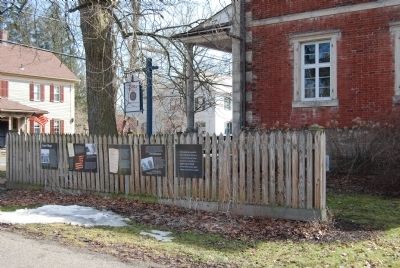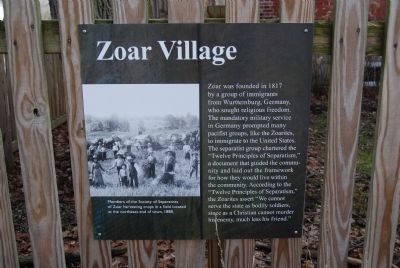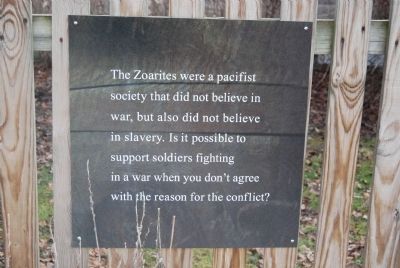Zoar in Tuscarawas County, Ohio — The American Midwest (Great Lakes)
Zoar Village
Topics and series. This historical marker is listed in these topic lists: Peace • Settlements & Settlers. In addition, it is included in the National Historic Landmarks series list. A significant historical year for this entry is 1817.
Location. 40° 36.806′ N, 81° 25.347′ W. Marker is in Zoar, Ohio, in Tuscarawas County. Marker can be reached from the intersection of East 3rd Street and Main Street (Ohio Route 212), on the right when traveling east. Sign panels are attached to a fence next to the Zoar Museum. Touch for map. Marker is in this post office area: Zoar OH 44697, United States of America. Touch for directions.
Other nearby markers. At least 8 other markers are within walking distance of this marker. Zoar Historic District (a few steps from this marker); Zoar Town Hall / Zoar and The Ohio & Erie Canal (within shouting distance of this marker); Zoar Garden (within shouting distance of this marker); Oldest Building in Zoar (about 400 feet away, measured in a direct line); The Zoar Hotel (about 400 feet away); The Cow Barn Foundation (about 500 feet away); Zoar Meeting House (about 600 feet away); Welcome To Zoar (approx. 0.2 miles away). Touch for a list and map of all markers in Zoar.
Also see . . . Historic Zoar Village. (Submitted on March 16, 2015, by Mike Wintermantel of Pittsburgh, Pennsylvania.)
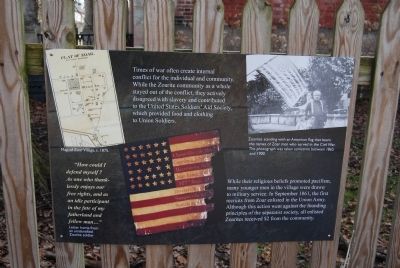
Photographed By Mike Wintermantel, March 15, 2015
3. Zoar Village - Panel 2
Top Middle Caption
Times of war often create internal conflict for the individual and community. While the Zoarite community as a whole stayed out of the conflict, they actively disagreed with slavery and contributed to the United States Soldiers' Aid Society, which provided food and clothing to Union Soldiers.
Bottom Right Caption
While their religious beliefs promoted pacifism, many younger men in the village were drawn to military service. In September 1861, the first recruits from Zoar enlisted in the Union Army. Although this action was against the founding principles of the separatist society, all enlisted Zoarites received $2 from the community.
Bottom Left Caption
"How could I defend myself? As one who thanklessly enjoys our free rights, and as an idle participant in the fate of my fatherland and fellow man..."
Letter home from an unidentified Zoarite soldier
Times of war often create internal conflict for the individual and community. While the Zoarite community as a whole stayed out of the conflict, they actively disagreed with slavery and contributed to the United States Soldiers' Aid Society, which provided food and clothing to Union Soldiers.
Bottom Right Caption
While their religious beliefs promoted pacifism, many younger men in the village were drawn to military service. In September 1861, the first recruits from Zoar enlisted in the Union Army. Although this action was against the founding principles of the separatist society, all enlisted Zoarites received $2 from the community.
Bottom Left Caption
"How could I defend myself? As one who thanklessly enjoys our free rights, and as an idle participant in the fate of my fatherland and fellow man..."
Letter home from an unidentified Zoarite soldier
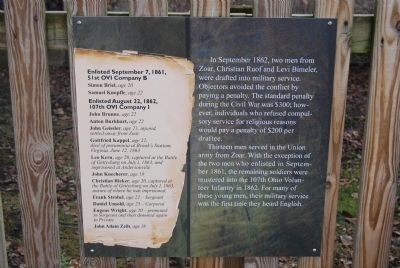
Photographed By Mike Wintermantel, March 15, 2015
4. Zoar Village - Panel 3
Right Caption
In September 1862, two men from Zoar, Christian Ruof and Levi Bimeler, were drafted into military service. Objectors avoided the conflict by paying a penalty. The standard penalty during the Civil War was $300; however, individuals who refused compulsory service for religious reasons would pay a penalty of $200 per draftee.
Thirteen men served in the Union army from Zoar. With the exception of the two men who enlisted in September 1861, the remaining soldiers were mustered into the 107th Ohio Volunteer Infantry in 1862. For many of these young men, their military service was the first time they heard English.
In September 1862, two men from Zoar, Christian Ruof and Levi Bimeler, were drafted into military service. Objectors avoided the conflict by paying a penalty. The standard penalty during the Civil War was $300; however, individuals who refused compulsory service for religious reasons would pay a penalty of $200 per draftee.
Thirteen men served in the Union army from Zoar. With the exception of the two men who enlisted in September 1861, the remaining soldiers were mustered into the 107th Ohio Volunteer Infantry in 1862. For many of these young men, their military service was the first time they heard English.
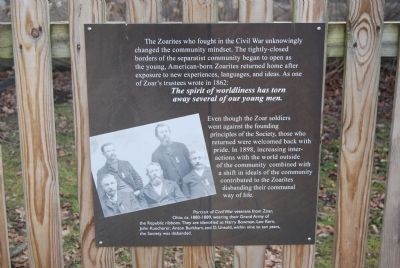
Photographed By Mike Wintermantel, March 15, 2015
5. Zoar Village - Panel 4
The Zoarites who fought in the Civil War unknowingly changed the community mindset. The tightly-closed borders of the separatist community began to open as the young, American-born Zoarites returned home after exposure to new experiences, languages and ideas. As one of Zoar's trustees wrote in 1862:
The spirit of worldliness has torn away several of our young men.
Even though the Zoar soldiers went against the founding principles of the Society, those who returned were welcomed back with pride. In 1898, increasing interactions with the world outside of the community combined with a shift in ideals of the community contributed to the Zoarites disbanding their communal way of life.
The spirit of worldliness has torn away several of our young men.
Even though the Zoar soldiers went against the founding principles of the Society, those who returned were welcomed back with pride. In 1898, increasing interactions with the world outside of the community combined with a shift in ideals of the community contributed to the Zoarites disbanding their communal way of life.
Credits. This page was last revised on June 16, 2016. It was originally submitted on March 16, 2015, by Mike Wintermantel of Pittsburgh, Pennsylvania. This page has been viewed 718 times since then and 17 times this year. Photos: 1, 2, 3, 4, 5, 6. submitted on March 16, 2015, by Mike Wintermantel of Pittsburgh, Pennsylvania.
